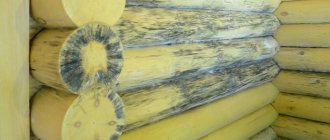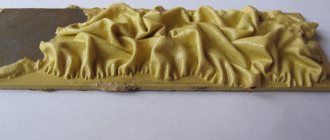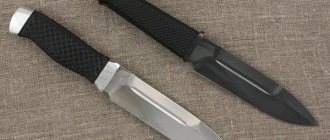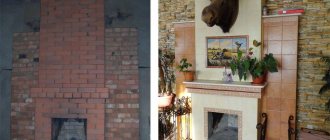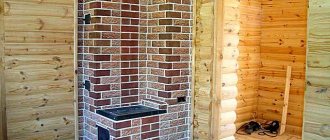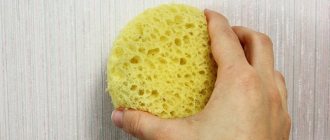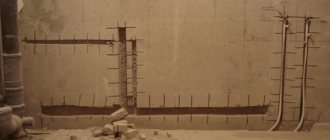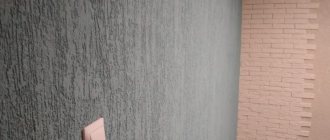How and with what to cover the stove so that it does not crack?
Any stove, even one made according to all the rules and traditions, can crack over time. This is due to various circumstances, but most often due to uneven heating. People who laid it out themselves or used low-quality materials are often interested in how and what to cover the stove so that it does not crack. Regardless of the reasons for the appearance of cracks and cracks, their presence poses a serious threat to the life and health of the inhabitants, since carbon monoxide enters the room through them. In this article we will figure out how to cover or plaster the stove to prevent it from cracking, and what materials to use for this.
How to cover up cracks
It is important not just to “cover up” them, but to examine them in time and seal them correctly to prevent the ingress of carbon monoxide. If you use low-quality material again, instead of one crack, several will appear and quickly.
So, the entire process of removing defects can be divided into 3 stages:
- analysis of the crack and the nature of its origin;
- preparation of solution;
- plastering and grouting.
Crack Analysis
Even a beginner can handle this stage. The task is to determine the location and size. In case of minor damage, as a rule, not through and therefore not dangerous, you can simply clean the bricks from the previously applied finishing and part of the mortar in the area of the crack. Seal them with the prepared solution and clean them so that the restoration work is not noticeable.
If we are talking about deep cracks, especially those through which smoke and a characteristic odor noticeably leaks, you will have to dismantle the bricks in this area and re-lay new ones. This is a painstaking job that requires the correct selection of solution and careful work.
Preparation of the solution
Regardless of the location and size of the cracks, a certain solution will be needed to eliminate them. These can be traditional materials - fireclay clay or a mixture based on river sand and clay, modern - stove glue, personally prepared - stove grout. By the way, you can also purchase it at a hardware store and dilute it yourself.
The table below shows examples of components for plastering stoves and their proportions.
Cement grade M400
Each material can be used in the work, but in order to understand how to plaster the stove so as not to crack, you need to understand each of them.
Fireclay clay
The most popular material for laying stoves and fireplaces, restoration and plastering. Fireclay clay is the most reliable material that has passed centuries of testing and is still very popular. The stoves, built on fireclay clay more than 100 years ago, still stand and do not crack.
Today you can buy fireclay clay at any hardware store. Standard packaging is 20 kg, but there are also individual packages of 5-10 kg or large batches of 50 kg. Before work, according to the instructions, the clay is soaked in water in a ratio of 2:1 and left for a day, after which they proceed directly to the plaster.
Clay and sand
The cheapest option for plastering the stove not only during the restoration of cracks, but also during the initial laying. Despite the fact that such material costs a penny, it is very flexible, easy to work with, and after the first two starts of the furnace it becomes very strong and durable.
How to cook:
- Pour 1 part clay with 3 parts water and leave for 72 hours.
- After one and a half days, stir the solution thoroughly, adding a little water, and strain it through a medium sieve (mesh cross-section up to 3 mm).
- Drain off excess water, then mix well again. The result should be a creamy “product” that is ready for the addition of sand.
- At this stage it is very important not to overdo it with sand. Add it gradually, continuing to stir the clay solution. Periodically remove the stick and check how much is stuck to it. As a result, there should be small fragments on the stick. If large pieces stick, continue mixing the solution with river sand. As a rule, the ratio is 1:2.5, where 1 part is clay, the rest is sand.
In order to avoid mistakes, watch the video on how to properly prepare clay for grouting cracks
Oven grout
Of course, it is best to purchase ready-made grout, which is simply diluted with water. It is expensive, but it is ideal for ovens. Very plastic, strong, durable, capable of maintaining integrity even at 10,000C.
Before sealing the cracks with a special grout, they are pre-moistened with water immediately before application.
For those who do not have the opportunity to purchase grout, we will tell you how to prepare a composition identical in characteristics to the grout.
Mix clay with water in a ratio of 1:3 and leave for 2-3 days. Next, add sand and gradually knead (see above for how to do this correctly). When finished, add straw and a pack of regular table salt.
Furnace glue
Very comfortable and practical material. which is also sold in all hardware stores. Its main advantage is ease of preparation and simple application.
There are 2 types of oven glue - plastic and hard. Plastic is used to seal cracks, while hard is a finishing coating that hardens very quickly.
The oven glue hardens within 15-20 minutes. To avoid wasting it, knead in small portions.
The procedure is as follows:
Cracks appear on any stove. In the video you will see how to seal cracks and crevices on a Russian stove with a stove bench
How to plaster a stove so it doesn't crack
The first step is always to seal the cracks and, after they have dried, they begin to cover the entire surface of the stove.
With any restoration method, it is necessary to remove the layer of plaster on the bricks/bricks at the site of damage, the cladding or the decorative layer.
Always before filling cracks with mortar, moisten them generously with water - this will form an excellent bond between the brick and the mortar, so that it will not fall out as it dries.
Cracks and cracks are sealed only with your fingers so that the solution penetrates deeply. Buy waterproof gloves.
Once all damage has been repaired, leave the oven for at least a week to allow everything to dry completely. And after that you can melt it completely - no more cracks will appear in this place.
Brick oven
The brick kiln is still in demand by people. Some populated areas are not gasified and a stove in a residential building is necessary. Sometimes it is an additional source of heat in order to save gas or electric heating.
In a country house you can not only spend the summer, but also celebrate New Year, Christmas and other holidays - romantic, unusual and healthy. A simple stove or fireplace will create comfort in the house; you will want to be at the dacha on weekends, sitting comfortably in the warmth.
When installing the stove, a number of conditions must be observed. In addition to choosing the correct design, installation location, components and materials, you need to understand what stoves are coated with so that they do not crack or crumble. A responsible attitude to the work at the construction stage of the building itself and the use of appropriate quality materials does not lead to cracks in bricks and finishing materials.
What requires more attention: a stove in the country, a wood-burning stove in the countryside, or a sauna stove?
Furnaces in which coal and brown coal are burned are subject to especially high temperature loads.
A few years after construction, repairs are required for bathhouse and country stoves. Heating appliances in which tin bread, loaves and pizza are baked almost around the clock are subject to intense temperature effects.
Italian Pompeii ovens are built in many countries. Pizza baked in such facilities has a special taste and smell. This oven is usually built outdoors. Food is cooked under a brick vault, under the influence of fire and the heat of heated bricks. There are two types of Pompeii ovens - Neapolitan (with a low arch, intended mainly for baking pizza) and Tuscan (with a high arch, which allows you to put a pot or pan inside and cook not only pizza, baked meat and fish, but also soups).
Exterior finishing of stoves
You can increase heat transfer, hide minor deformations and give the stove a more aesthetic appearance by plastering or tiling.
Plastering is the most common; it is possible after settling and complete drying of the masonry.
Important! The walls of the oven intended for plastering should not be dirty and smooth; the solution will not have the necessary adhesion to them. The plastered surface will have defects after drying.
Tiling gives an elegant look and protects the room from the penetration of flue gases when small cracks appear in the masonry.
The importance of plastering work
Furnace finishing options are not limited to just applying layers of plaster. The cladding is done using fireclay or ceramic tiles, decorative stone, metal elements, and is also completely abandoned if the “bare” stove masonry looks neat and stylish. However, plastering, which was practiced by our ancestors, has its advantages and practical benefits:
- correction of masonry defects;
- leveling the surface of the walls;
- protection from insects that make nests in the seams between bricks;
- preventing the release of carbon monoxide into the room through cracks and gaps in the finishing layer;
- reducing the risk of fire;
- increasing heat capacity, which allows you to heat a house using less fuel;
- safety during operation, since the surface of the oven does not heat up to temperatures that could harm people.
In addition, plastering is an accessible and low-cost process.
It is also worth taking into account its versatility and flexibility in use. Plaster is effectively used in working with all types of stoves, from finishing from scratch to restoring old structures, and decoration possibilities are limited only by imagination
What causes cracks
When malfunctions of the furnace equipment are discovered during use, the first thought that arises is: the furnace is cracking, what should I do? To begin with, it doesn’t hurt to figure out what led to this.
The following factors may be the reasons:
- donkey foundation or structure itself;
- unscrupulous craftsmen and unprofessional work;
- low quality material or unsuitable mortar for masonry or plastering was used;
- the drying process of the masonry is disrupted;
- long heating breaks, sudden temperature changes;
- the technology was not followed when applying each layer during plastering;
- The ventilation system is faulty, condensation.
Note!
Chipboard: what is it? Types, application features, photos, sizes, thickness, explanation, manufacturers
DIY houses made from shipping containers step by step: instructions, diagrams, pros and cons, photos, design
Working pressure in the heating system in a private house: what it should be, how to create it, instructions for adjusting it yourself
Reasons for appearance
Before properly and reliably caulking the stove, in order to prevent repeated malfunctions, you need to know what can affect the integrity of the stove coating:
- during a long break in heating the house and sudden temperature changes;
- the furnace was laid using low-quality mortar;
- Perhaps the reason is the settlement of the building or foundation. In this case, it will be necessary to carry out major repairs to the foundation, increasing its size and strength;
- after laying the stove, the process of normal drying of surfaces was disrupted;
- when plastering the stove, a low-quality solution was used or a thick or very thin layer was applied;
- Perhaps the reason is faulty ventilation and condensation deposited on the walls of the furnace.
Is it possible to use a stove with cracks?
There is only one answer to this question: it is prohibited. Do not use a stove with cracks and endanger people’s lives. If there are no structural defects, it is necessary to begin troubleshooting as soon as possible.
Important! Fires in most cases result in death due to carbon monoxide released, not fire.
How long does it take to dry?
It is not recommended to use the oven until the solution is completely dry. When using different materials, this period may vary. Using heat-resistant glue as a putty, the layer of solution will dry within a few hours.
It will take more time for the solution of clay and sand to dry and form. In this case, you will be able to use the stove only after a day. Then the brick oven, protected from cracks with mortar, will remain crack-free for a long time.
Therefore, we do not advise you to rush, immediately flooding your Russian stove with a stove bench. Repairing cracks in a furnace is a simple but important job. The choice of material for the solution is a purely individual matter. The main thing is to do the work carefully and responsibly. Then your house will always be light and clean, without the smell of burning and smoke penetrating through the cracks in the walls of the stove.
Diagnosis of problems
The diagnostics of all surfaces will answer the question why a brick stove is cracking. The worst option would be widening through brick cracks. You can’t do this without the help of a specialist; you may need to re-lay the furnace.
Small cracks in bricks caused by high heat allow you to carry out the work yourself. The cracks need to be filled and the surface re-plastered.
Oven adhesive
In building materials retail outlets there is a dry adhesive special mixture, as well as a ready-made solution of fireclay clay and cement. This glue is durable and fire-resistant. It is convenient to fill the voids of bricks with ready-made plastic material.
The dry composition is not difficult to dilute in accordance with the instructions. It is recommended to work with a small amount of material, as it dries quite quickly. Along with the advantages, ready-made glue has the disadvantage of being quite expensive.
Clay-sand mixture
Affordable economy class material. To prepare the proper quality solution, only high-quality clay and river sand are used. The clay is poured with water in a convenient container and diluted to the state of milk, then rubbed through a fine sieve.
When the clay and water settle, the liquid top layer is drained. Sand, sifted twice, is added to the clay mixture, ratio 1:2. The liquid composition is diluted from the clay mixture to a creamy consistency and mixed thoroughly.
Note!
Three-way valve in a heating system: instructions on how to choose and install correctly in a private home
Why the bottom of the battery is cold and the top is hot - let's look at the reasons. Review of recommendations on what to do and how to fix it
How to insulate a dog house for the winter with your own hands and inexpensively - step-by-step instructions with photos and descriptions of all stages
It’s easy to check whether the solution is ready. If small pieces of the mixture remain stuck to the stirrer, then the solution is ready, and if large enough pieces remain, then by diluting with water the mixture is brought to the required condition.
A solution containing clay is more likely to lead to defects. There are no exact instructions for preparing the solution; it is prepared based on the experience of the master. There are not many professional craftsmen, so such a solution is not often in demand.
What and how to cover the stove
Over time, the operation of the stove leads to the formation of cracks. The reason for the appearance of cracks is uneven heating of the stove masonry and the evaporation of excess moisture on its surface.
Cracks on the Russian stove
Cracks in the stove's masonry cause difficulties in its operation and danger for its users. Most often, cracks in the stove form at the seams between individual parts of the stove masonry, which is made of refractory bricks.
When cracks form on the surface of the stove, it is necessary to answer the question of how to cover the stove and how and with what to cover the seams in the stove, in places where cracks have formed on its surface. There is no doubt that the material with which the stove must be coated must be fireproof, easy to apply to the surface of the stove and have good adhesion to the edges of cracks.
Materials for caulking the stove
Cover the stove with clay
So, how to cover the stove with clay. The simplest and most proven material used for filling cracks and crevices on a stove is traditional clay, with which a classic solution for filling cracks in a stove is prepared. This solution consists of a mixture of clay and river sand in a 1:1 ratio. This solution is thoroughly mixed to avoid lumps. Moreover, it is recommended to pass this solution through a metal sieve with large cells.
To check the strength of the resulting solution, you should make a ball out of it and throw it on the floor. If cracks form, a little more clay must be added to the solution.
When covering a stove, the question inevitably arises of how to properly cover the stove with clay.
To do this, it is recommended to fulfill the following condition: To avoid the formation of cracks on the stove during its operation, it is recommended to wrap the stove lining with gauze soaked in a liquid clay solution and allow it to dry. After which you can begin plastering the stove with the prepared clay solution. As practice shows, this, in most cases, is enough to prevent the formation of cracks on the surface of the stove when using it.
In order to cover the stove with clay you will need the following tools and equipment::
To seal cracks and crevices in the furnace, non-traditional solutions are also used, consisting of the following components:
In order to prepare such a solution, you need clay, in the amount of 4 buckets, pour a bucket of water and let it soak and brew for 4-5 hours. After this, mix it thoroughly. Add a bucket of fine river sand to the clay solution and mix thoroughly again.
Then gradually add about 50 kilograms of chaff into this mixture. According to the advice of experienced stove makers, this mixture must be kneaded with your feet. When mixing this solution, care must be taken to ensure that no lumps form. The readiness of the solution is checked in a simple folk way - if the leg pulled out of the solution remains clean, then the solution is already ready. You will also be interested in familiarizing yourself with the types of dry construction mixtures.
In addition to adding chaff to the mixture for coating the stove, you can also add horse manure. In this case, the undigested residue of the herb serves to reinforce and strengthen the material and to seal cracks in the oven. Note that horse manure should contain excess grass and be dry.
Mixture-solution for sealing the stove
Despite their cheapness and availability, it is clay-based mixtures that are most often used in the construction of furnaces and their repairs, since when they dry, they will retain plasticity, such as is determined by the composition of the prepared solution. Other materials used to bind the filler, such as cement or lime, are more susceptible to cracking when they dry, especially on a surface that is subject to sudden and large temperature changes, such as on the surface of a furnace. A stove is a very ancient human invention that has stood the test of time for a long time, and it is for this reason that such common materials as clay and sand are used in the construction of stoves and their repair.
Some stove makers add table salt to the solution, which serves to strengthen the solution and improve its thermal conductivity characteristics. The proportions of salt are individual, but, as a rule, do not exceed one glass for the entire amount of solution.
The clay for preparing the solution must be clean, reddish in color with minimal sand impurities. Tested clay can be stored for future use before it is needed to repair the stove. Moreover, the already prepared and unused solution also does not need to be thrown away. It is well preserved and may still be useful for use. In addition, this solution can be used to seal cracks in the chimney from the stove, which will guarantee its long service life.
Well maintained Russian stove
Maintenance of your stove must be carried out in a timely manner , avoiding the formation of large cracks and crumbling of the plaster. Firstly, small cracks are easier to repair, and secondly, this will prevent the formation of other cracks and ensure the safety of your stove.
Of course, repairing a stove and sealing cracks in it is a labor-intensive task, but, in the absence of laziness, the process is accessible to everyone, especially since it does not require special tools and skills, and the experience gained in repairing the stove will give you the opportunity to apply your strengths in other housework. You will need it when caring for other heat sources in your home that use fire, such as a fireplace. Moreover, they have a stove and a fireplace, they have quite a lot in common. When sealing cracks in an oven, special attention must be paid to built-in metal elements - doors, bolts, vents and ovens. The material for working with them remains the same - clay solution. Additionally, what may be needed is more practice and accuracy when performing such work and, possibly, a larger selection of tools for the job.
To perform the work efficiently, it makes sense for you to familiarize yourself with the basic methods and approaches in the construction of furnaces and the materials used in this case.
The most correct approach to this is practice, when everything is done with your own hands under the supervision of an experienced mentor. Of course, you can use the acquired skills both at home and among your family friends, teaching them such an exciting and useful activity as repairing their own stove. And it would be more correct to see it more than once, but to do it yourself once.
Fireclay clay
One of the best materials to cover the stove so it doesn’t fall off. Affordable, sold in stores, packaged in 20 kilograms. Resistant to moisture and temperature. Also intended for plastering surfaces.
The finished solution is obtained as follows: fireclay clay is mixed with cement and sand, the ratio of the components is 2: 1: 7, respectively, water is added. For better pliability of the material, you can initially fill the clay with water, then wipe out the lumps, add cement and sand. The thickness of the mixture depends on what type of work is being carried out, and skill experience also plays a role.
Putty materials
Inventive people are ready to give advice on any matter, including the choice of materials for repairing stoves. Recommendations must be taken carefully, separating the wheat from the chaff.
A mixture of clay and sand
There are well-known putty compositions that have been tested many times over. You can use them without any doubt.
It is customary to cover stoves with clay. The material definitely inspires confidence, but first you need to check what type and grade of clay is suitable for making mechanically strong, heat-resistant putty. The stove should be sealed so that it does not crack later.
The composition is prepared by mixing equal parts of clay and sand. Both components must first be sifted and separated from large impurities. Due to the fact that the clay composition in different deposits varies greatly, it is advisable to check the strength of the mixture.
Advice! You need to make balls from the slurry formed after adding water, let them dry well and examine them carefully. If cracking is not visible, the materials are suitable.
It would be advisable to tighten the inspection requirements by throwing dried cakes from a low height. If they did not collapse and successfully passed the tests, the chances of making a high-quality repair of the furnace increase.
When preparing homemade putty, monitor the condition of the wooden mixing spatula. The gruel should not stick to it. If clay adhesion is noticeable, it is better to increase the amount of sand in the mixture.
Of course, if possible, it is advisable to take a special type of clay - fireclay. It is characterized by fire resistance and strength. You can buy it in building materials departments. Before use, fireclay raw materials should be kept in water for a couple of days.
Adding straw and horse manure
A popular folk method of preparing grout for stoves is to add chopped straw or chaff (husks, chaff) to the mixture of clay and sand. You need a lot of it. So, if 4 buckets were taken of clay, one bucket of sand will be needed, and straw - from 40 kg to 45 kg. You can hear advice about the benefits of adding salt to the grout at the rate of half a regular glass per bucket of the mixture. It is recommended that the quality and quantity of additional components be determined based on the local situation.
Important! You cannot use mortar with straw for laying. It is only suitable for covering surface cracks, for plaster.
In some places, people recommend covering stoves with a mixture containing horse manure. Now it is not so easy to find it, it makes no sense to insist on such technology.
Special formulations
If there are building materials stores nearby and you are willing to spend money, it is better to buy ready-made adhesives: soft or hard. The viscous solution is convenient for covering small cracks. Complete plastering of the stove can be done with solid compounds. Sometimes cracks in the masonry are sealed with a special heat-resistant sealant, and small cracks are filled with asbestos fiber.
Note! The finished product contains clay, sand, cement of proven quality, mineral and synthetic additives.
If the solution or paste is prepared correctly and the work is done correctly, the result is guaranteed by the manufacturer. What is important is that special putty compounds can be used if the stove is finished with tiles or decorative bricks. They are plastic, prevent the formation of repeated cracks and provide reliable adhesion to the masonry.
Oven grout
To eliminate defects that occur in the oven, ready-made heat-resistant grout is sold. Because of its high cost, home craftsmen prefer to make such a solution themselves.
The clay is prepared as for a clay-sand mixture. The soaked clay slurry is combined with sifted sand and while mixing, chopped straw is added, the component ratio is 1:4:5. 1 kg of coarse salt is added to the finished solution, which makes the composition more plastic and resistant to cracking.
Grout perfectly fills voids. You can also use it to plaster the stove surface with the first rough layer.
Covering stove cracks
The material for the upcoming work has been selected, and another question arises: how to properly seal the stove?
You can start working only after cleaning the brick from decorative finishing and plaster. Using a suitable tool, the gaps between the masonry with cracks are widened to fill an area of about 10 mm with adhesive.
When using ready-made adhesive solutions, it is advisable to adhere to some rules:
- prepare the working solution in a limited volume due to the drying speed;
- Wet all cracks with water;
- tightly fill the gaps with adhesive;
- Lubricate the top of the oven with the prepared solid mixture;
- wait for it to dry completely and start plastering.
An unheated stove is a bad option for carrying out repair work with materials containing clay. It is recommended to heat it slightly; this will help you see imperfections and eliminate defects before the putty dries.
The sequence of work will be slightly different:
- Before sealing the cracks, stir the mixture again until smooth (the contents have different densities);
- make sure the material is of high quality. To do this, you can manually make a spherical object, and if cracks appear on it, add a little water;
- wet all the cracks with water and fill tightly with glue (it’s safer to use your hands);
- Plaster also after final drying. Next you can use whitewash.
Briefly about the main thing
If cracks appear on the stove, it is important to find out how critical they are and what to do about them. Inspection of the masonry allows you to determine the cause. We can easily eliminate the defect if the cause of the cracks is infrequent or improper use, finishing errors or design flaws. Restoration will not help if a problem with the foundation or an error in the calculations is revealed.
Ready-made and home-made compounds are used for smearing. All of them, from sand-clay mixtures to ready-made adhesive compositions, are capable of qualitatively eliminating defects. To prevent cracks from appearing again, a technique has been developed for applying a plaster layer to the stove; special sealant pastes are used to restore metal surfaces.
Ratings 0
Oven overheating
Having installed a new stove, or repaired damage to the old one, you should not test its strength by heating it to its fullest.
The first fire must be carried out with a small amount of firewood, increasing the amount each time. And then there will be no need to get rid of the next problems again.
